Paul Revere Biography
Summary
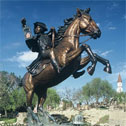 Paul Revere was one of the key figures of the revolutionary movement in New England colonies. He was also a craftsman known for his works of silver. Born on December 22, 1734 in Boston Revere first became famous for his craftsmanship. His work was well known in Boston, especially silverware and tea sets. His other well-known specialty was the engraved printing plates. Paul Revere was one of the key figures of the revolutionary movement in New England colonies. He was also a craftsman known for his works of silver. Born on December 22, 1734 in Boston Revere first became famous for his craftsmanship. His work was well known in Boston, especially silverware and tea sets. His other well-known specialty was the engraved printing plates.
When revolutionary mood became growing in Boston, Revere became involved as an active member of the Boston’s Sons of Liberty chapter lead by Samuel Adams. He also used proceeds from the trade to finance revolutionary activities. One of his most publicized engraving works where his trade and his political views crossed, was the representation of the Boston Massacre...
Read the full story
Early Life
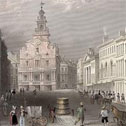 Paul Revere was born in Boston’s North End, in December 1734. Sometimes his birthday is mistakenly stated as January 1st, 1735 (or December 22nd Old Style), which was actually the day when he was baptized as stated in the church records. Likely he was born few days before that in late December 1734. His father’s name was Apollos Rivoire and his mother’s Deborah Hichborn. His father was a Huguenot silversmith who had immigrated to America as a refugee from religious persecution in France. Apollos learned his trade as a gold and silversmith from John Coney. Later he anglicized his name as Paul Revere... Paul Revere was born in Boston’s North End, in December 1734. Sometimes his birthday is mistakenly stated as January 1st, 1735 (or December 22nd Old Style), which was actually the day when he was baptized as stated in the church records. Likely he was born few days before that in late December 1734. His father’s name was Apollos Rivoire and his mother’s Deborah Hichborn. His father was a Huguenot silversmith who had immigrated to America as a refugee from religious persecution in France. Apollos learned his trade as a gold and silversmith from John Coney. Later he anglicized his name as Paul Revere...
Read the full story
Education
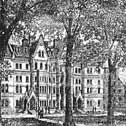 o better understand education that Paul Revere manage to receive it will be useful to quickly describe how Boston’s school system operated at that time. It commonly started with primitive infant schools ran by dames where children were taught not much reading or writing but mostly “manners”. Learning their ABC’s was the end of schooling for many kids. Those who advanced further attended one of the five public schools that existed by donation of the Governor. Private schools were even fewer. Just over 500 students attended such schools, both public and private. The schools were divided into Latin (or grammar) schools that provided higher quality education and into Writing schools, mostly for those students whose aspiration were to become tradesmen. Among those sent to the North Writing school was the young Paul whose father probably planned him to continue tradition of silversmith trade... o better understand education that Paul Revere manage to receive it will be useful to quickly describe how Boston’s school system operated at that time. It commonly started with primitive infant schools ran by dames where children were taught not much reading or writing but mostly “manners”. Learning their ABC’s was the end of schooling for many kids. Those who advanced further attended one of the five public schools that existed by donation of the Governor. Private schools were even fewer. Just over 500 students attended such schools, both public and private. The schools were divided into Latin (or grammar) schools that provided higher quality education and into Writing schools, mostly for those students whose aspiration were to become tradesmen. Among those sent to the North Writing school was the young Paul whose father probably planned him to continue tradition of silversmith trade...
Read the full story
Family
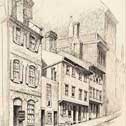 Revere’s father, whose original name was Apollo Rivoire, was a French Huguenot. Huguenots were French Protestants whose religion was persecuted in predominantly Roman Catholic France. One of the most famous episodes in the history was the Bartholomew's Day massacre of 1572 when thousands of Huguenots were slaughtered in Paris. This event started the centuries of Huguenot flight to protestant European countries, such as England and later to the American Colonies. During this time more than four hundred thousand of them left the country. Among those who left were Apollo Rivoire’s parents, Isaac and Serenne... Revere’s father, whose original name was Apollo Rivoire, was a French Huguenot. Huguenots were French Protestants whose religion was persecuted in predominantly Roman Catholic France. One of the most famous episodes in the history was the Bartholomew's Day massacre of 1572 when thousands of Huguenots were slaughtered in Paris. This event started the centuries of Huguenot flight to protestant European countries, such as England and later to the American Colonies. During this time more than four hundred thousand of them left the country. Among those who left were Apollo Rivoire’s parents, Isaac and Serenne...
Read the full story
Pre-revolution Activities
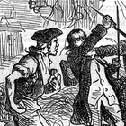 In 1757 Paul Revere came back from the French Indian War were he served as a second lieutenant. After the war he resumed his normal life, married Sarah Orne, had children and continued working as silversmith. In 1757 Paul Revere came back from the French Indian War were he served as a second lieutenant. After the war he resumed his normal life, married Sarah Orne, had children and continued working as silversmith.
Revere was an independent businessman who later became an active political leader and fought for independence from the British. He was a versatile businessman and artisan who adapted to economic difficulties by innovating and applying his silversmith talent to new demands. He was known for his work with silver, however as economic times pressed he even advertised as a dentist, published music and drew political cartoons. Later he would use this talent to shape anti British public opinion...
Read the full story
Revolutionary War
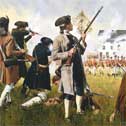 Revere’s famous Midnight Ride on April 19, 1775 lead to the Battles of Lexington and Concord which marked the beginning of the Revolutionary War. Revere’s famous Midnight Ride on April 19, 1775 lead to the Battles of Lexington and Concord which marked the beginning of the Revolutionary War.
At the beginning of the war in 1775 Revere continued to serve as a messenger for the Massachusetts Committee of Correspondence. His actual military service started in 1776 and continued until 1779. As a committed patriot P.R joined the Massachusetts infantry militia in the rank of Major. Few months later he transferred to the artillery and was promoted to Lieutenant Colonel, and in late 1778 became commander of Castle Island in Boston Harbor. He was put in charge of three artillery companies.
Unfortunately despite the great cause it was fighting for, Patriot’s military organization suffered from the lack of leadership and experience causing numerous conflicts and politicizing between the commanders. For Revere this became apparent during his participation in the failed Penobscot Expedition...
Read the full story
After the Revolution
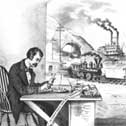 Paul Revere believed that industrialization and a robust economy would create a powerful nation. As an entrepreneur he saw business opportunities everywhere. He observed a shortage of products and started importing them from England. He sold hardware and household goods in a store which he ran until 1789. Paul Revere believed that industrialization and a robust economy would create a powerful nation. As an entrepreneur he saw business opportunities everywhere. He observed a shortage of products and started importing them from England. He sold hardware and household goods in a store which he ran until 1789.
With the help of his sons Revere started experimenting with different metals other than silver. It is believed that at least two of his sons Paul Jr. and Joseph were junior partners in the business. Joseph studied bell casting in Europe and Paul Jr. learned with bell founder George Holbrook...
Read the full story
Later Years
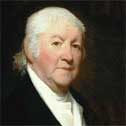 Encouraged by profit and patriotism Revere became a wealthy businessman while helping the nation develop a strong economy. In 1811, at the age of 76, Paul Revere retired leaving his well established business to his sons and grandsons. Encouraged by profit and patriotism Revere became a wealthy businessman while helping the nation develop a strong economy. In 1811, at the age of 76, Paul Revere retired leaving his well established business to his sons and grandsons.
During his later years the great patriot devoted considerable time to the Massachusetts Charitable Mechanics Association of which he was its first president. This group was meant to help small business owners to improve working conditions...
Read the full story
|